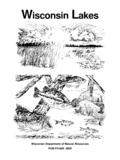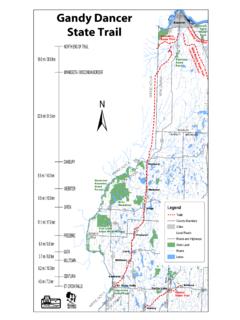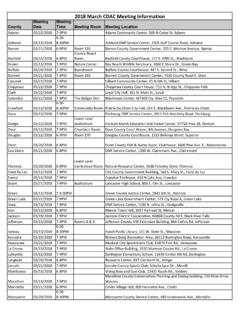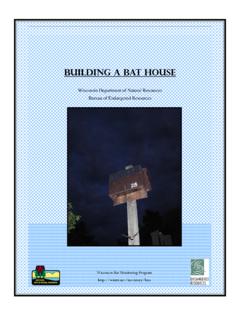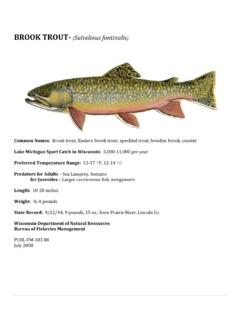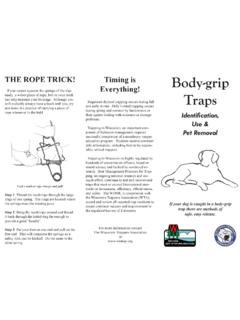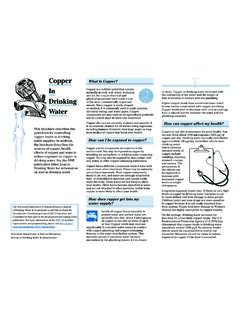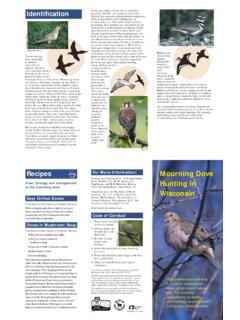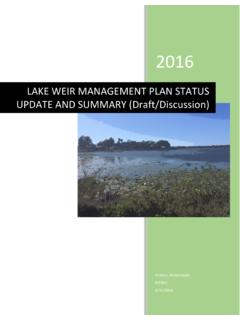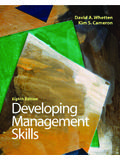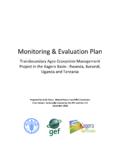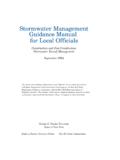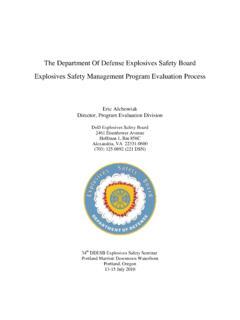Transcription of GO FISHING! - dnr.wi.gov
1 Find links to fishing licenses, season dates, regulations, where to fish and more us on Facebook ( )Watch us on YouTube ( user/ WIDNRTV)FY ISIGN UP for Fisheries Updates. Go to fishingwisconsin. org to sign up and stay informed on fisheries fishwisconsin on Twitter. Subscribe at new initiative aims to create new participants or increase par-ticipation rates of current or lapsed Inland Trout January 6 (5 ) to May 4 General Hook and Line InlandMay 5 to March 3, 2019 General Inland Trout May 5 (5 ) to Oct. 15 Largemouth BassNorthern Zone HarvestMay 5 to March 3, 2019 Smallmouth BassNorthern Zone Catch-and-ReleaseMay 5 to June 15 Smallmouth BassNorthern Zone Harvest June 16 to March 3, 2019 Large and Smallmouth Bass Southern Zone May 5 to March 3, 2019 Musky Northern Zone May 26 to Nov. 30 Musky Southern Zone May 5 to Dec. 31 Northern Pike May 5 to March 3, 2019 Walleye May 5 to March 3, 2019 lake Sturgeon (hook and line) Sept.
2 1 to Sept. 30 Free fishing WeekendJune 2 - 3, 2018 summerJanuary 19 -20, 2019 winter2018 SEASON , Bureau of Fisheries ManagmentR3 and the future of Wisconsin fishingUnder Wisconsin s new R3 pro-gram, Department of Natural Re-sources staff hope to recruit new anglers, retain them once they re active and reactivate those who step away from fishing for a while. State fisheries officials are counting on the three Rs to boost Wisconsin residents and nonresidents interest in not readin, ritin and rithmetic. Instead the DNR plans to focus on recruitment, retention and reactiva-tion. In terms to which anglers can relate, R3 is: 1) Recruitment - re-cruitment is luring prospective an-glers in and setting the hook, 2) Re-tention - retention is keeping them on the line but playing them gently and 3) Reactivation - reactivation is putting on another lure and entic-ing them to bite again. Nationally, it has been documented that there is a long-term decline in hunting and angling participation.
3 Reversing this trend - growing and sustaining the number of anglers - poses a tremendous challenge. Spe-cifically, current national participa-tion trends show younger, more diverse audiences are reluctant to take up fishing , while older white males are aging out of the sport. These trends are evident among Wisconsin fishing license holders and raise concerns about the contin-ued availability of funding for con-servation efforts as well as negative statewide economic impacts. Sport- fishing currently generates $ bil-lion in economic benefits each year and supports 22,000 jobs in Wiscon-sin. The R3 initiative is not unique to Wisconsin. The concept has been around for some time. Recently, however, it has become a national focus for fishing and hunting with the development of hunting guid-ance for R3 strategies developed by the Wildlife Management Institute and the counterpart angling guid-ance developed by the Recreational Boating & fishing Foundation and the Aquatic Resources Education Association.
4 It has also been elevated as a prior-ity within the DNR, with the cre-ation of an R3 section. This section is comprised of wildlife, fisheries and law enforcement staff who are in the process of developing a state-wide R3 plan. The plan will likely include hiring a coordinator, de-veloping partnerships, providing learn to hunt and fish programs, implemening outreach and market-ing campaigns and evaluating the desired outcomes. What can you do to be an R3 advo-cate? Take someone fishing for the first time,. If you haven t bought a fishing license in recent years, now is the perfect time to do so. And if you already plan on being on the water, buy an extra lure or two don t worry, the money spent is be-ing put back into the a the FISHING! TMF PhotoI am excited to report that 2017 was another very productive year for the fisheries program in Wisconsin. We produced over 7 million fish for stock-ing our waters and were also able to fill many critical vacancies around the state including 10 fisheries biologists and 10 fisheries management techni-cians.
5 These new hires along with our seasoned employees are going to have another busy year in may consider 2018 to be the year of the plan . For the first time in DNR history, the fisheries program will be developing a statewide trout manage-ment plan. Efforts will begin in Janu-ary and continue throughout the year with many opportunities for input from you the angler. We will also be updat-ing the 30-plus year old lake Superior management plan as well as revising the decade-old sturgeon management plan. There will be ample opportunity for stakeholder input as these plans are developed. It is our job to manage these amazing fishery resources but you as a stakeholder are also an important com-ponent in making our fisheries great and we want to hear from you. To find out more about how to be involved in any of the planning efforts in 2018 visit am looking forward to some good open water fishing when the weather heats up.
6 Maybe I ll see you on the wa-ter. 2 Fish Wisconsin! fish are here, there, everywhere! Where are you going to be in 2018?WALLEYEI nterested in a water? Want more information? Contact the local fisheries biologist BARRON COUNTYS ilver lake - 331 acres. In a 2017 fish-eries survey, the density of adult ( 15 in) walleye was estimated to be fish/acre, which was an increase from the most recent survey in 2009 when it was fish/acre. Of the 320 adult walleye handled in the survey, 65% were between 15 to 20inches in length. Current regulation: The Silver lake walleye fishery is managed with a 15-in minimum length limit, but walleye 20-24 inches may not be harvested, and only 1 walleye longer than 24 inches may be harvested, 3 fish daily bag limit. Access information: There is one public boat landing at Grant County Park on the south end of Silver lake off CTH B. The park is maintained by Barron County and includes a restroom, picnic shelter, volleyball net, and a swimming beach.
7 Silver lake is a deep seepage lake , and the water level can fluctu-ate by as much as 12 feet over several years. Silver lake has excellent water quality and is one of few lakes in Bar-ron County that has walleye natural BROWN, OCONTO AND MARINETTE COUNTIESFox River, Oconto River, Peshtigo River, Menominee River and Green Bay Since 2012, Wisconsin DNR has assessed the magnitude of walleye spawning migra-tions into the Fox River located in south-ern Green Bay and into the Oconto, Peshtigo and Menominee Rivers found along the west shore of Green Bay by using daytime electroshocking. Elec-trofishing is conducted just below the dams in these rivers to capture Walleye during the estimated peak of the spring spawning run. Electroshocking runs in 2017 were conducted at least twice per river between March 28 and April 18 with the water temperature varying by river from 36 F to 44 F. During elec-troshocking we captured 1,248 Walleye that ranged in length from 14 to.
8 In 2017, the spring run was later than normal and was very short in length likely due an unusually cold spring with a fast warm-up. DNR also assesses the walleye population during the fall to look at young of year production and year class strength. In 2017, dur-ing our nighttime YOY Walleye index electroshocking survey on the lower Fox River, we captured 434 Walleye that had average length of 14 . Most of the captured Walleye were less than 18 in length and many (27%) were young of year Walleye. During YOY Walleye assessments on Green Bay, we captured 111 Walleye that averaged 14 in length. Similar to the Walleye captured on the Fox River, Walleye captured on Green Bay were mostly less than 18 in length and many were young of the year. Results of our 2017 Fall electrofishing index surveys show that the relative abundance of young of the year (YOY) Walleye at the fall fingerling stage was above average on the Fox River and slightly below aver-age on Green Bay.
9 When the river and bay YOY catch is combined, it appears that 2017 was an above average year for Walleye. Walleye from the exception-ally large 2013 year class are now in the 18 to 22 range and were commonly caught by anglers and seen in DNR surveys in 2017. It is likely that this year class and others produced from 2014 through 2017 will carry the fishery in the near future. Current regulation: The rules vary by location and anglers should check for walleye fishing rules in the Wisconsin-Michigan Boundary, Tributary Stream to lake Michigan and the lake Michigan sections of the regu-lation pamphlet for season and harvest rules. Access information: There are many good boat launches in the area. Good shore fishing opportunities exist on the Fox, Menominee, Oconto and Peshtigo Rivers. Check the lake Michi-gan page for access information. Since 2007 the only poor year class was the 2012 year class. Recruitment in the 2010 s has been exceptional with good year classes produced regularly Relative abundance of young-of-year Walleye in the lower Fox River (DePere Dam to mouth), lower Green Bay (south of a line drawn from Longtail Point to Point Sable), as measured by catch per unit effort (CPUE; number per hour) from data collected in electrofishing index surveys during BURNETT COUNTYU pper Clam lake (1,338 acres) and Lower Clam lake (366 acres).
10 2017 survey data found Clam lake walleye ranged from to inches. The average length was inches. Fifty-eight percent of the adult walleye sampled were be-tween 15 20 inches. The two lakes are shallow and featureless, so it can be dif-ficult to find fish. Many anglers who are successful use trolling to find wall-eye roaming the lakes. Current Regula-tion: 15 - 20 may be kept, except one fish may be over 24 ; daily bag limit of 3 fish. Access: There are two boat launch-es on Upper Clam lake and one launch on Lower Clam lake . Upper Clam lake has one landing on the SE portion of the lake off of Clam lake Drive and the other landing is on the SW side at the end of Cumberland Point Rd. The launch for Lower Clam lake is on the N side of Hwy 70. Walleye present in Clam lake today likely originate from wild walleye populations in the Clam River upstream. These immigrants have taken advantage of the dramatic changes to vegetation and turbidity caused by common carp in the lake .
